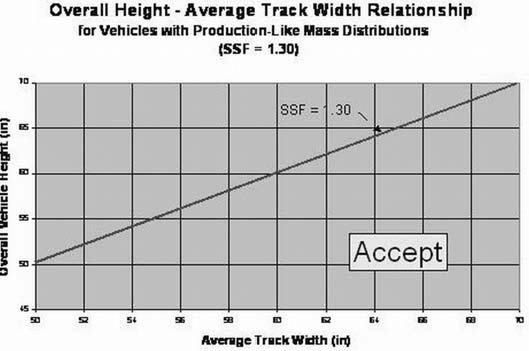SPLIT from 2008 Ladies School: Roll over discussion
Posted: Thu Nov 20, 2008 11:09 pm
GUIDELINES FROM THE SSC
A. Rollover potential guidelines
The SSC has reviewed the allowance of competing cars with higher roll centers and has prepared the following chart to be used as a guideline for assisting Regional members in determining whether a vehicle has a higher than average potential to roll over in Solo competition. Vehicles falling into the acceptance range still have the probability to roll over but they are less likely to roll over than those that are not in the acceptable range are. One method of assessing rollover resistance and one level more sophisticated than the Static Stability Factor (SSF), is using “stability margin”. This idea is that the vehicle’s steady cornering level at which incipient rollover would occur (two wheel lift or 2WL) should exceed the steady cornering g-level provided by the tires (maximum lateral acceleration or MaxLat) by some margin. This should only be applied to categories for which the Center of Gravity (CG) height estimation based on roof height could be presumed to be reasonably valid. This chart is for Stock, Street Touring, and Street Prepared categories vehicles. An approach of this type is required to help event officials assess the rollover risk potential of vehicles which fall in a gray area between traditional Solo cars and those which clearly have a “high center of gravity”. While it is imperfect, it should strike a balance between risk reduction and admission of the most vehicles to Solo while introducing a consistent procedure for doing so. This chart is for Regional Officials and Technical Inspectors to determine the acceptance level of high roll center vehicles referred to in Section 3.1. The measurements are to be taken from the ground to the tallest point of the vehicle for the Overall Vehicle Height and the normal track measurement as stated in the GCR for the Average Track Width. Vehicles with a SSF less than 1.30 should not be permitted to compete in our Solo II events due to their higher risk of roll over.

A. Rollover potential guidelines
The SSC has reviewed the allowance of competing cars with higher roll centers and has prepared the following chart to be used as a guideline for assisting Regional members in determining whether a vehicle has a higher than average potential to roll over in Solo competition. Vehicles falling into the acceptance range still have the probability to roll over but they are less likely to roll over than those that are not in the acceptable range are. One method of assessing rollover resistance and one level more sophisticated than the Static Stability Factor (SSF), is using “stability margin”. This idea is that the vehicle’s steady cornering level at which incipient rollover would occur (two wheel lift or 2WL) should exceed the steady cornering g-level provided by the tires (maximum lateral acceleration or MaxLat) by some margin. This should only be applied to categories for which the Center of Gravity (CG) height estimation based on roof height could be presumed to be reasonably valid. This chart is for Stock, Street Touring, and Street Prepared categories vehicles. An approach of this type is required to help event officials assess the rollover risk potential of vehicles which fall in a gray area between traditional Solo cars and those which clearly have a “high center of gravity”. While it is imperfect, it should strike a balance between risk reduction and admission of the most vehicles to Solo while introducing a consistent procedure for doing so. This chart is for Regional Officials and Technical Inspectors to determine the acceptance level of high roll center vehicles referred to in Section 3.1. The measurements are to be taken from the ground to the tallest point of the vehicle for the Overall Vehicle Height and the normal track measurement as stated in the GCR for the Average Track Width. Vehicles with a SSF less than 1.30 should not be permitted to compete in our Solo II events due to their higher risk of roll over.
